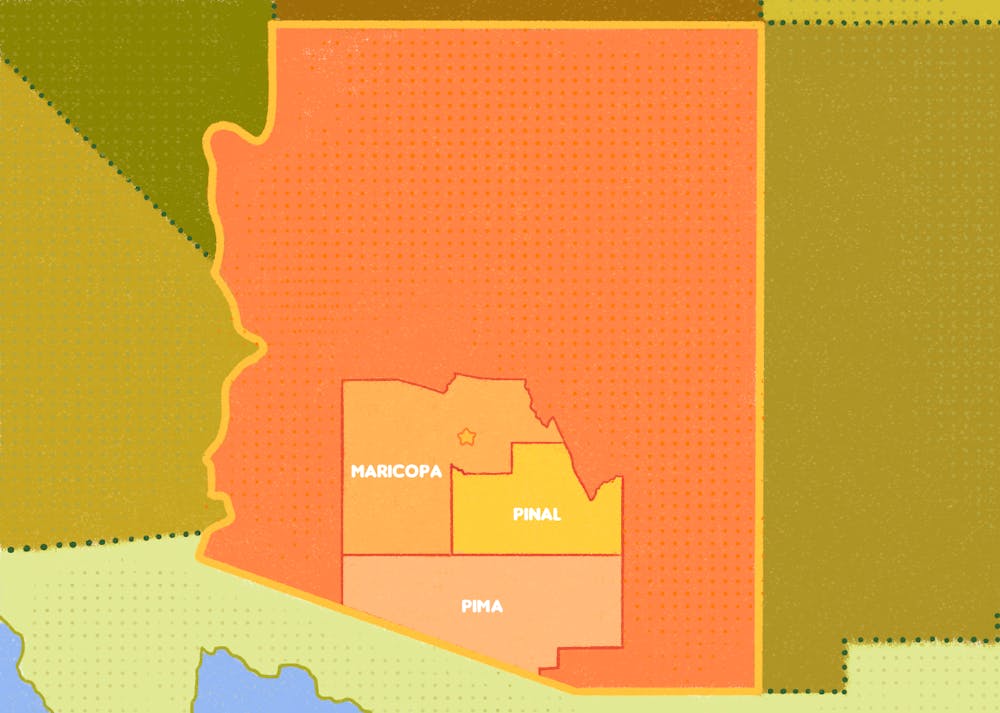Arizona overall was considered a battleground in the 2020 election, but Maricopa County specifically drew national attention due to its large student population and its status as the fourth-largest county by population in the U.S.
Maricopa County lived up to the expectations of being an important part of the Democrat's push in Arizona, with the final results in the county showing 49.81% of votes going to former Vice President and now President-elect Joe Biden compared to the 47.65% votes cast in favor of President Donald Trump.
A win for Biden and the Democrats in Maricopa County is a shift from 2016 when Trump won the county with 47.67% of the votes compared to 44.83% that went to then-Democratic presidential candidate Hillary Clinton.
The idea of an area being a battleground means it could have a large impact on the election because it is not possible to assume whether the area will vote Democratic or Republican until the votes are counted.
Monaliza Hernandez, a freshman studying nursing, said she felt pressure as a voter because of the state's and county's status as being battlegrounds.
"Every single vote counts if you're in a swing state," Hernandez said. "So, I feel like it raises the stakes."
Since ASU's four campuses are all located within Maricopa County, the college student population largely contributed to the perception of the county as a battleground.
Young people, and specifically college students, tend to lean in favor of the Democratic Party in how they vote. A 2017 study showed that 55% of voters from ages 18 to 35 in 2016 identified as a Democrat or Democratic-leaning.
Armando Montero, the director of ASU affairs with the Arizona Students' Association and a member-elect for the Tempe Union High School District Governing Board, echoed Hernandez's point that a large student voter turnout was important in races like in Arizona.
"It's such a battleground county, that votes being cast by college students could make or break a race," Montero, a sophomore studying political science and economics, said last Tuesday before all votes in Maricopa County were counted.
Voters between ages 18 and 29 were largely in support of Biden in Arizona, with 60% of these voters supporting Biden compared to the 36% in support of Trump, according to data from an exit poll provided by the Center for Information and Research on Civic Learning and Engagement.
Kyle Nitschke, the organizing director of the Arizona Students’ Association, said students tend to vote more Democratic because they see it as the best place for growth.
"Most young voters recognize that the Democratic Party has the most room for growth in fighting for the progressive ideas that young voters believe in, like tackling climate change, like the Green New Deal,” Nitschke said.
Despite these trends among students, Hernandez, who voted for Biden, said she was still surprised Arizona flipped blue.
"I was shocked when Arizona turned blue," Hernandez said. "I think most of it came from people who were voting in Maricopa County, like our age."
Legislative District 26, which includes the ASU Tempe campus, saw a notable increase in voter turnout among those ages 18 to 30, according to data provided on Nov. 11 by the Arizona Students' Association.
Compared to the 2018 midterms, over 8,000 more voters between the ages 18 and 30 cast ballots in District 26.
"Things are looking good," Nitschke said about the student voter turnout in 2020. "We think we have the highest student vote turnout that we have ever seen before."
Hernandez, who lives on the Downtown Phoenix campus, said she noticed the increased voter turnout first-hand.
"I remember everyone was so excited when they got their ballots in the mail," Hernandez said. "They were like, 'Yo, I got my ballot!'"
Montero said he hopes this election will mark a shift in the focus of politicians' platforms to prioritizing younger voters rather than forgetting them.
"Historically, college students and young people are thrown to the side," Montero said. "College-age students are playing a much larger role in elections and could have a dramatic shift in electoral politics going into the future."
Nitschke echoed this sentiment and hopes that politicians will start listening more to young voters.
"What we are hoping to see is attention, not just on what is going on during elections and during voting, but how politicians are reacting to young voters," Nitschke said. "Because now, they're seeing increased voter turnout and increased youth activism."
Hernandez said she was excited to see the college-aged vote have more of an impact in the future.
"I feel like a lot of college students voted in this election, which is really great because we're the voice of the new generation," Hernandez said.
Reach the reporter at mcfisch4@asu.edu and follow @morgfisch on Twitter.
Like The State Press on Facebook and follow @statepress on Twitter.

Morgan Fischer is the politics editor, she works with her desk to cover topics related to politics in the ASU community. She has previously worked as an intern for RightThisMinute.




